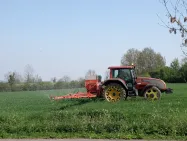
A new study by researchers at University of Calgary published in the Proceedings of the National Academy of Sciences, suggests that the long-term legacy of past fertilizer applications must be considered in reducing nitrate contamination of aquatic ecosystems. The study finds that nitrogen fertilizer leaks out in the form of nitrate into groundwater for much longer than was previously thought. The long-term tracer study revealed that three decades after synthetic nitrogen (N) was applied to agricultural soils, 12–15% of the fertilizer-derived N was still residing in the soil organic matter, while 8–12% of the fertilizer N had already leaked toward the groundwater.
Abstract
Increasing diffuse nitrate loading of surface waters and groundwater has emerged as a major problem in many agricultural areas of the world, resulting in contamination of drinking water resources in aquifers as well as eutrophication of freshwaters and coastal marine ecosystems. Although empirical correlations between application rates of N fertilizers to agricultural soils and nitrate contamination of adjacent hydrological systems have been demonstrated, the transit times of fertilizer N in the pedosphere–hydrosphere system are poorly understood. We investigated the fate of isotopically labeled nitrogen fertilizers in a three–decade-long in situ tracer experiment that quantified not only fertilizer N uptake by plants and retention in soils, but also determined to which extent and over which time periods fertilizer N stored in soil organic matter is rereleased for either uptake in crops or export into the hydrosphere. We found that 61–65% of the applied fertilizers N were taken up by plants, whereas 12–15% of the labeled fertilizer N were still residing in the soil organic matter more than a quarter century after tracer application. Between 8–12% of the applied fertilizer had leaked toward the hydrosphere during the 30-y observation period. We predict that additional exports of 15N-labeled nitrate from the tracer application in 1982 toward the hydrosphere will continue for at least another five decades. Therefore, attempts to reduce agricultural nitrate contamination of aquatic systems must consider the long-term legacy of past applications of synthetic fertilizers in agricultural systems and the nitrogen retention capacity of agricultural soils.
Citation
Sebilo M, Mayer B, Nicolardot B, Pinay G, Mariotti A, 2013. Long-term fate of nitrate fertilizer in agricultural soils, Proceedings of the National Academy of Sciences
The link to the journal article can be found here. You can also read articles summarising the study here or here.
You can also read more in the FCRN research library on studies focusing on the Nitrogen cycle, or using the search words Nitrate or Fertilizer.




Comments (0)